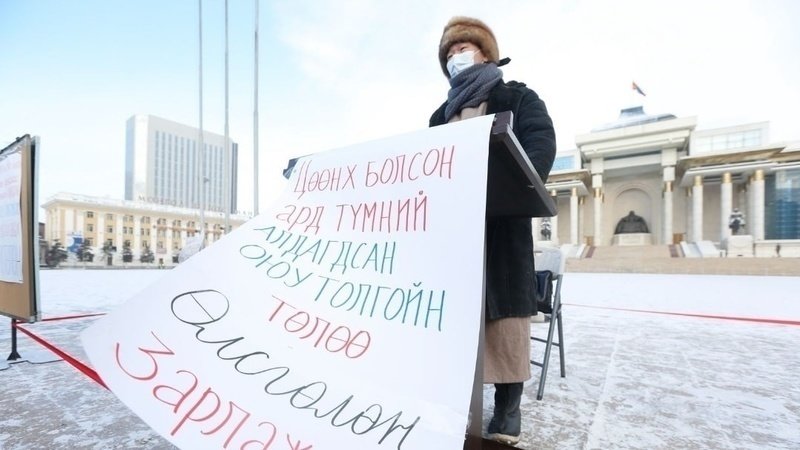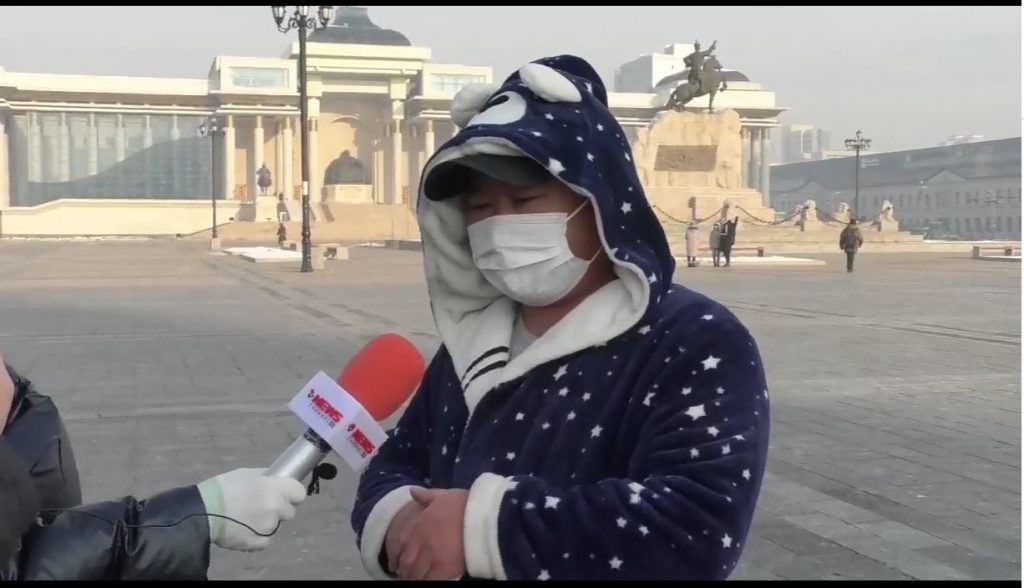By Marissa J. Smith
After the massive #уокогцор strikes last week that preceded the resignation of Prime Minister U. Khurelsukh and his Cabinet, the weekend also saw demonstrations with fewer participants begin on Sukhbaatar Square, focusing on the OT agreement.
MP S. Ganbaatar of the MPRP, who was elected in the Ikh Khural 2020 elections and also ran as the MPRP Presidential candidate in 2016, settled on the square in front of the Parliament Building, with a poster announcing that he was hunger striking “for Oyu Tolgoi that has been taken from the People, who have become few.” The words, written also in the alternating red/sky blue of the Mongolian flag, are unabashedly national-populist. Updates on the demonstration, continuing at the time of writing, can be viewed on Facebook by searching the hashtag #өлсгөлөн_зарлаж (“Hunger striking”) and on Ganbaatar’s facebook page.
(S. Ganbaatar and his placard, from change.org petition)
This led Julian to point out to our regular contributors that the hunger strike is an established form of political action in modern Mongolia, at least, and ask us to put our heads together to consider how it has become an established form.
Here is what we have come up with:
- We know of no instances prior to 1990 of hunger strikes being used in Mongolia as a form of organized political protest.
- Discussing the 1990 hunger strikes organized by the Mongolian Democratic Union, in his Modern Mongolia (2005), Morris Rossabi cites interviews with Tomor-Ochiriin Erdenebileg to suggest that inspiration was drawn from the Tiananmen Square demonstrations.
- As Mendee Jargalsaikhan writes in his PhD dissertation (p. 79), there were also April, 1990 hunger strikes in Khuvsgul and elsewhere outside of Ulaanbaatar.
- In his “Mongolia in 1994” overview for Asian Survey, Sheldon Severinghaus documented a hunger strike organized by the Mongolian Democratic Union.
- One of our regular contributors also collected interviews that credited Dr. Charles Hyder, an American physicist whose hunger strike of over 200 days in front of The White House in 1986, with inspiration. Hyder was widely publicized throughout the Soviet Bloc as a counterpart to Sakharov. Rossabi also includes mention of “a hunger strike conducted in front of the White House by an American scientist” in his discussion, citing Jasper Becker (though apparently conflating Hyder’s anti-nuclear waste storage movement of the 1980s with anti-Vietnam War protest).
- After his conviction and sentencing, former MPRP President N. Enkhbayar conducted a hunger strike and was hospitalized. Images of of Enkhbayar in hospital were widely circulated and probably remembered by many readers of the blog.
It appears that the form of the “hunger strike,” which S. Ganbaatar is currently enacting, was established in 1990 and continued to be used by Mongolian Democratic Union parties until 1994, at least. However, since the 2010s it has been MPRP (Enkhbayar himself and at least one member of his party which split from the MPRP in 2011 — S. Ganbaatar) that has used the “hunger strike.” It is also notable that the #уокогцор protests did not feature hunger strikes, and though A. Otgonbayar, another third party politician who ran as part of the Shine Esvel coalition in the 2020 Parliamentary elections, joined S. Ganbaatar on the square, when he was one of the first participants in the #уокогцор protests he dressed up as a new mother. (For the OT agreement demonstrations, S. Ganbaatar and A. Otgonbayar have appeared in quite masculine “traditional” Mongolian furs).
(A. Otgonbayar being interviewed on Facebook Live by Ugluu.mn, 1/20/21)
In conclusion, at the present moment at least, to hunger strike seems to call not only upon the 1990 demonstrations, but also to put oneself in solidarity with Enkhbayar as a “victim of corruption,” so it is unsurprising perhaps that hunger striking is not a more widespread form of political action in today’s Mongolia.
(Now the #уокогцор protests did also feature people stripping down to bathing suits and underwear in the cold — now where did that come from?!)


 Follow
Follow